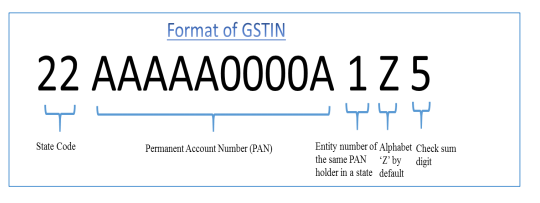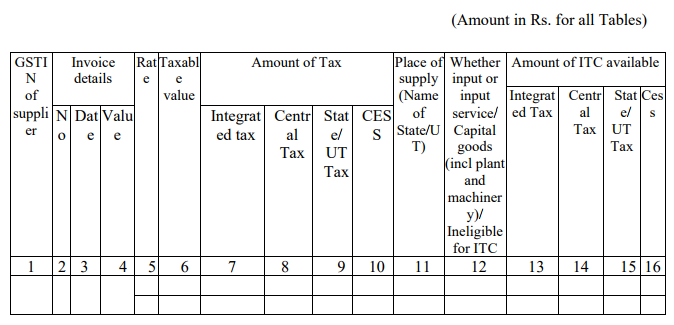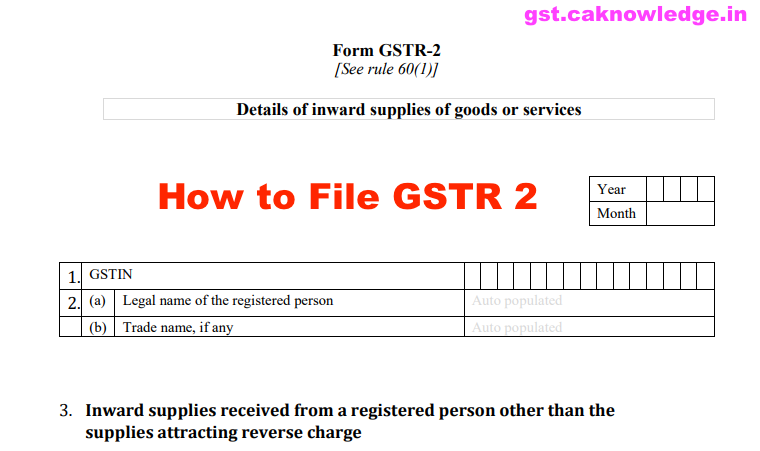GSTR 2: Details of all inward supplies of taxable goods and services to be filed by registered taxable recipient of the goods and services. The due date of filing this form is 15th of next month.According to CGST Act 2017, every registered taxable person is required to furnish details of Inward Supply in GSTR-2 Form. In the previous article, we understand various aspects about GSTR 1, now here we discuss about all headings of GSTR 2…
Terms used in GSTR 2:
- GSTIN: Goods and Services Tax Identification NumberUIN: Unique Identity Number
- UQC: Unit Quantity Code
- HSN: Harmonized System of Nomenclature
- POS:Place of Supply (Respective State)
- B to B: From one registered person to another registered person
- B to C: From registered person to unregistered person
Guide on Filing GSTR 2 on GST Portal
As per CGST Act 2017 – Every registered person, other than a person referred to in section 14 of the Integrated Goods and Services Tax Act, 2017, required to furnish the details of inward supplies of goods or services or both received during a tax period under sub-section (2) of section 38 shall, on the basis of details contained in Part A, Part B and Part C of FORM GSTR-2A, prepare such details as specified in sub-section (1) of the said section and furnish the same in FORM GSTR 2 electronically through the common portal, either directly or from a Facilitation Centre notified by the Commissioner, after including therein details of such other inward supplies, if any, required to be furnished under sub-section (2) of section 38.
Heading along with the details required for GSTR 2:
GSTIN –GST Number (GSTIN) is a unique 15 digit number which is allotted to the assessee at the time of filing an application for registration for Goods and Service Tax. Each taxpayer will be allotted a state-wise PAN-based 15-digit Goods and Services Taxpayer Identification Number (GSTIN). Just like PAN Card No is required for payment and filing of Income Tax Returns, similarly GSTIN is required for payment and filing ofGST Returns.. The GSTIN of the taxpayer will be auto-populated at the time of return filing.

Advertisement
Legal name of the registered person or Trade Name –
Name of the taxpayer, will also be auto-populated at the time of logging into the commonGST Portal.
Tax Period, Month, Year –ATaxable person is required to select from a drop down the relevant month and year respectively for which GSTR-1 is being filed.
Inward supplies received from a registered person other than the supplies attracting reverse charge – Most of the inward supplies from a registered taxable person will get auto-populated here. This information will flow from GSTR-1 filed by the supplier. Any further claim can be added by the registered person in this section which is not auto-populated as a reason of:
- Non-filing of GSTR-1 by Supplier
- Supplier filed GSTR-1, however, transaction got missed

Inward supplies on which tax is to be paid on reverse charge
Table 3 and 4 to capture information of:
- (i) Invoice-level inward supply information, rate-wise, pertaining to the tax period reported by supplier in GSTR-1 to be made available in GSTR-2 based on autopopulated details received in GSTR-2A;
- (ii) Table 3 to capture inward supplies other than those attracting reverse charge and Table 4 to capture inward supplies attracting reverse charge;
- (iii) The recipient taxpayer has the following option to act on the auto populated information:
- a. Accept,
- b. Reject,
- c. Modify (if information provided by supplier is incorrect), or
- d. Keep the transaction pending for action (if goods or services have not been received)
- (iv) After taking the action, recipient taxpayer will have to mention whether he is eligible to avail credit or not and if he is eligible to avail credit, then the amount of eligible credit against the tax mentioned in the invoice needs to be filed;
- (v) The recipient taxpayer can also add invoices (not uploaded by the counterparty supplier) if he is in possession of invoices and have received the goods or services;
- (vi) Table 4A to be auto populated;
- (vii) In case of invoices added by recipient tax payer, Place of Supply (PoS) to be captured always except in case of supplies received from registered person, where it is required only if the same is different from the location of the recipient;
- (viii) Recipient will have the option to accept invoices auto populated as well as add invoices, pertaining to reverse charge only when the time of supply arises in terms of section 12 or 13 of the Act; and
- (ix) Recipient tax payer is required to declare in Column No. 12 whether the inward supplies are inputs or input services or capital goods (including plant and machinery).
Amendments in Details of Inward Supplies Received in Earlier Tax Periods –Under this head, the taxable person can amend any detail with respect to goods or services received in earlier months. This information can be filled manually. Subsequently, the supplier will also get a notification regarding this modification. A supplier needs to accept this change in his GSTR-1A return.
Goods/Capital Goods received from Overseas (Import of Goods) –Any kind of import of input goods or capital goods in the previous month needs to be reported under this head. Imports are considered as inter-state supply under Goods and Services Tax Law. According IGST liability will be determined basis such declaration.
Amendments in Goods / Capital Goods Received from Overseas (Import of goods) of Earlier Tax Periods –Any amendment in amount/tax calculated on imported goods can be made under this heading. Here, the registered taxable person is also required to furnish detail of all changes in the bill of Entry / Import Report.
3. Details relating to import of Goods/Capital Goods from outside India as well as supplied by an SEZ Unit to be reported rate-wise by recipient tax payer in Table 5.
4. Recipient to provide for Bill of Entry information including six digits port code and seven digits bill of entry number.
5. Taxable Value in Table 5 means assessable value for customs purposes on which IGST is computed (IGST is levied on value plus specified customs duties). In case of imports, the GSTIN would be of recipient tax payer.
6. Table 6 to capture amendment of information, rate-wise, provided in earlier tax periods in Table 3, 4 and 5 as well as original/ amended information of debit or credit note. GSTIN not to be provided in case of export transactions.
- Details of Debit/Credit Notes –Thetaxable person is required to report all debit and credit notes with respect to inward supply here. Any debit/credit note issued under reverse charge mechanism will get auto-populated here from counter-party GSTR-1 and GSTR-5.
- Amendment to Details of Credit /Debit Notes of earlier tax periods –Any amendment in debit /credit note pertaining to previous months shall be reported under this heading. This will mainly include the changes made under reverse charge mechanism transactions. Any other modification will be auto-populated here.
- Supplies Received from Unregistered Person –All kind of supplies other than from a normal registered taxable person will be reported under this heading. This will include supplies from a composition dealer, unregistered person, and other exempt/nil/non-GST supplies. Also, both inter-state and intra-state supplies need to be reported here.
- ISD Credit Received –Input Credit received from an Input Service Distributor registered under Goods and Services Tax will get auto-populated in this heading. These will be scenarios where head-office has received input services and some portion of this credit is transferred to the branch office.
7. Table 7 captures information on a gross value level.
8. An option similar to Table 3 is not available in case of Table 8 and the credit as distributed by ISD (whether eligible or ineligible) will be made available to the recipient unit and it will be required to re-determine the eligibility as well as the amount eligible as ITC.
9. TDS and TCS credit would be auto-populated in Table 9. Sales return and Net value columns are not applicable in case of tax deducted at source in Table 9.
10.The eligible credit from Table 3, Table 4 and Table 8 relating to inward supplies to be populated in the Electronic Credit Ledger on submission of its return in Form GSTR-3.
11.Recipient can claim less ITC on an invoice depending on its use i.e. whether for business purpose or non-business purpose.
12.Information of advance paid pertaining to reverse charge supplies and the tax paid on it including adjustments against invoices issued should be reported in Table 10. 13.Table 12 to capture additional liability due to mismatch as well as reduction in output liability due to rectification of mismatch on account of filing of GSTR-3 of the immediately preceding tax period. 14.Reporting criteria of HSN will be same as reported in GSTR-1.
Recommended Articles
- Role of Company Secretary
- Role of CS in GST
- When will GST be applicable
- Filing of GST Returns
- Returns Under GST
- GST Registration
- GST Rates
- Role of CMAs in GST
- Role of Chartered Accountants
- HSN Code List
- GST Login
- GST Rules

